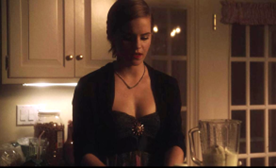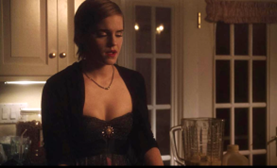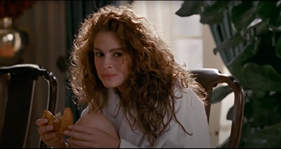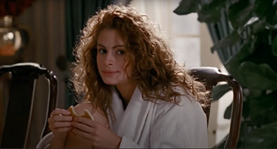FILM / In Praise of the Continuity Error / Payton McCarty-Simas
Image © Working Title Films | Amblin Entertainment
I keep a folder on my phone called "continuity error🤍." This brief compendium of movie discontinuity began with a scene that's been mystifying me since I watched The Perks of Being a Wallflower at home for the first time, when I discovered one of the most perplexing "continuity errors" I've ever seen. Since then, I've collected these ever-so-slightly cracked moments of cinematic rupture like a crow collects pretty pieces of trash, waiting to make my case for their artistic merit in a culture that treats them like an unzipped fly. But before I get into all that . . . let's have a milkshake.
For those who don't know or don't remember, Perks tells the almost operatically angsty tale of a high school freshman, Charlie (Logan Lerman), in a year of pulpy self-discovery that's traumatic and cathartic by turns ("welcome to the island of misfit toys," anyone?). Appropriately enough, the moment that changed how I think about cinematic continuity takes place at a party, when Charlie smokes weed for the first time. His new friend and crush, Sam (Emma Watson), is making him a milkshake. As he goofily rambles about the word milkshake and how pretty her eyes are, she scoops vanilla ice cream into a blender in a wide two-shot. He tells her about his best friend Michael while she pours milk into the blender in a medium closeup, the blender only partially visible at the bottom of the frame (this frame recurs for the rest of the scene). The milkshake is, of course, not the point of this interaction. Sam soon freezes in horror when Charlie reveals that Michael shot himself several months before, the concoction sitting abandoned in the blender, a metaphor for his adolescence as a precarious departure from childhood's simplicity. But, after this reveal, the emotional climax of the scene, Charlie asks her where the bathroom is, tension still lingering in the air. And when we cut back for her to tell him, shock still written across her face, the milkshake in the corner of the frame is transformed. After we've watched Sam carefully construct what Stephen Chbosky's script literally describes as a "perfect vanilla milkshake," the contents of the blender are now, as if by magic, all chocolate, a fresh carton of chocolate milk sitting beside the blender after only the very briefest of cutaways.
People love to hate continuity errors in our internet era, scrupulously unpacking movies with the superior and derisive air of a cruel teacher grading a struggling student's work. In other words, for a generation raised on CinemaSins, this kind of microscopic "mistake" is typically the stuff of gleeful ridicule (ding!). Watching this scene over and over again, though, for me, it's become something of a portal, a gateway into thinking about the minutiae of a film's production rather than evidence of its weakness: Did the Perks crew run out of vanilla ice cream (that meltiest of foods) midway through shooting the scene? Could the PA assigned to sprint to the store for more not find any for some reason? Did that same PA, in a desperate ploy to keep their job after such a failure, buy the chocolate milk as a way to smooth over the mistake, hoping the final edit would imply ("we'll fix it in post!") that Sam added chocolate while Charlie was sharing his personal trauma? Movie magic! This kind of blink-and-you'll-miss-it "error," subtle until you see it, boggling once noticed, speaks to the fundamental delicacy of making films, a process so defined by orchestrating tremendous amounts of labor and millions on millions of details to create the seamless illusion of immersive continuity and diegesis. Rather than think of these oddball details as cracks in an otherwise perfect facade, they can be understood as keyholes into the humanity of these oft-impersonal studio products.
That's not to say that these kinds of diegetic disruptions aren't hilarious. For example, the absurdity of its existence, the fact that, (for me at least,) the milkshake stole a scene intended to subvert humor with tragedy adds a new layer of unfortunate gallows humor I relish. Then there are of course more glaringly ridiculous examples that speak to a film's inability to construct verisimilitude in the first place: Dame Judi Dench's unrendered human hand in Tom Hooper's disasterpiece Cats (2019) was so humiliating for the already-embattled production that a new, hand-less cut of the film was rushed to theaters around the country–– not that it improved matters. In that case, the continuity error became an apt synecdoche for the broader artistic blunder of turning Andrew Lloyd Webber's beloved musical into a $100 million uncanny valley populated by eerily smooth, pint-sized human-cat hybrids thirsty for milk. This film never achieved true suspension of disbelief; its artificiality remained on the surface, viscerally highlighted by way of animation seemingly no one (besides the director himself) enjoyed, and thus the failure to animate Dench's hand at all made manifest a collective desire to tear the film's nightmarish stylings asunder. Conversely, noticing the anachronistic coffee cup in Game of Thrones or the car driving by in Lord of the Rings are satisfying precisely because these productions are so wildly successful at creating worlds outside our own, making a magic trick a little more comfortingly familiar and human through this small slip.
That being said, small-scale continuity errors—as my fantasy version of how Charlie's milkshake changed its flavor attests—are often seemingly products of human ingenuity, not errors at all but small, sometimes scrappy, fixes. In Pretty Woman, as Vivian and Edward have breakfast and discuss his soulless career, the croissant she so enthusiastically devours becomes a pancake midway through. The pancake, almost identical in shape and size, with a bite taken out of almost the same place, is incredibly easy to miss. Maybe the team ran out of croissants and carefully matched baked goods, maybe Julia Roberts just wanted a pancake! But the fact that such an obvious difference barely registers within the context of a well-cut scene speaks to the fact that—much to CinemaSins' chagrin—cinematic time is itself discontinuity. Not only is each frame a rupture from the last, the illusion of movement just a trick our eyes play on us, as editor Walter Murch put it in his book In the Blink of an Eye, both on set and in the editing room (where scenes are shot and assembled out of order and time is deconstructed through the creation of flashbacks, jump cuts, and nonlinear narratives) "Discontinuity is King." For Murch, the emotional reality of any given scene takes precedence in the edit over temporal or spatial concerns. Vivian's pancake is close enough to feel correct even if its presence jars when noticed. It's amazing!
This fluidity is at the heart of many films' emotional verisimilitude, and filmmakers sometimes use deliberate continuity errors to bolster this fact. The disappearing chairs in The Shining imperceptibly unsettle the audience's sense of reality, lending a queasy feeling to the mise-en-scene of an already queasy altercation. Less pointedly but equally to the point, Paulie's cigar growing and shrinking within the span of a conversation in Goodfellas speaks to an edit more focused on performance and flow than literality. As avant-garde filmmaker and theorist Jean Epstein beautifully put it in his essay "Photogénie and the Imponderable," "time is the fourth dimension . . . [and] the gaze which cinematography lets us cast over nature, where such time is neither unique nor constant, is perhaps more fecund than the one we cast out of egocentric habit," namely our own mortal commitment to linear temporal progression. When, for example, a CinemaSins video suggests that it's a "mistake" that the train leaves a station in Bullet Train after 45 seconds rather than the "minute" stated by one of the characters, it misrepresents how movie time is supposed to flow. In a 60 Minutes interview, Greta Gerwig recounts how her choice to use hyper-stylized matte paintings and obvious practical effects in Barbie was all "about showing the work. I wanted to see that it was authentically artificial. [The movie is] about kids, it's about playing with toys. The language of play has to be part of it." The same can be said of all filmmaking, and continuity errors not only show the work, they show the play.
Payton McCarty-Simas is a freelance writer and artist based in New York City. Their writing has been featured in The Brooklyn Rail, Film Daze, and Bright Lights Film Journal among others. Their first book is scheduled for release in early 2025.







